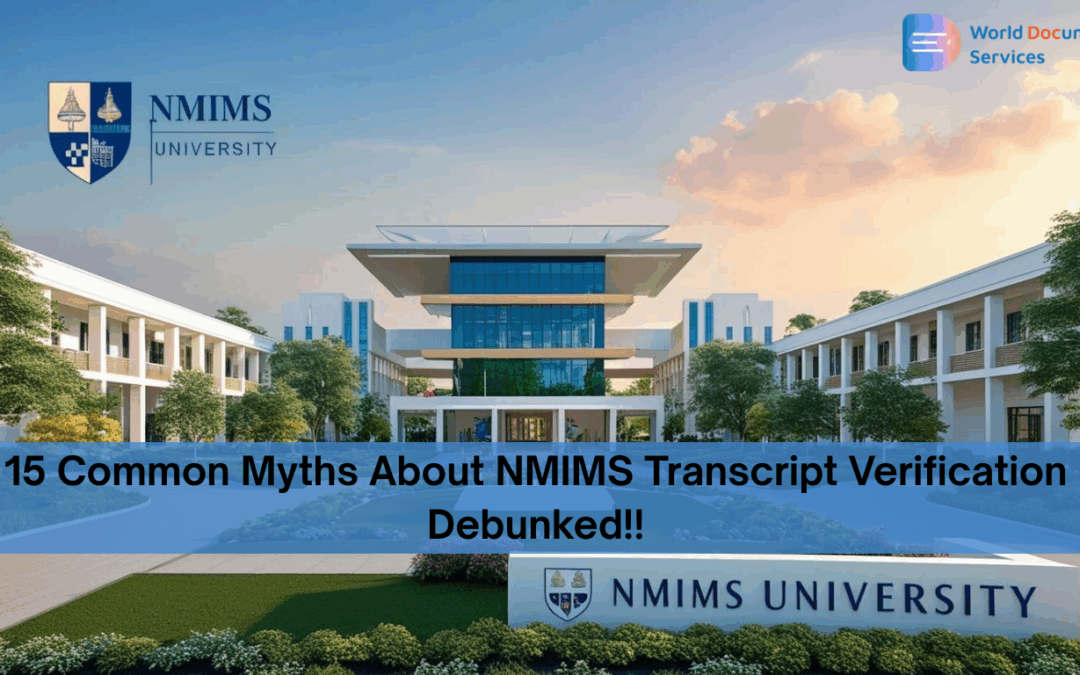
by Aayushi Thadwani | May 30, 2025 | Transcripts from University
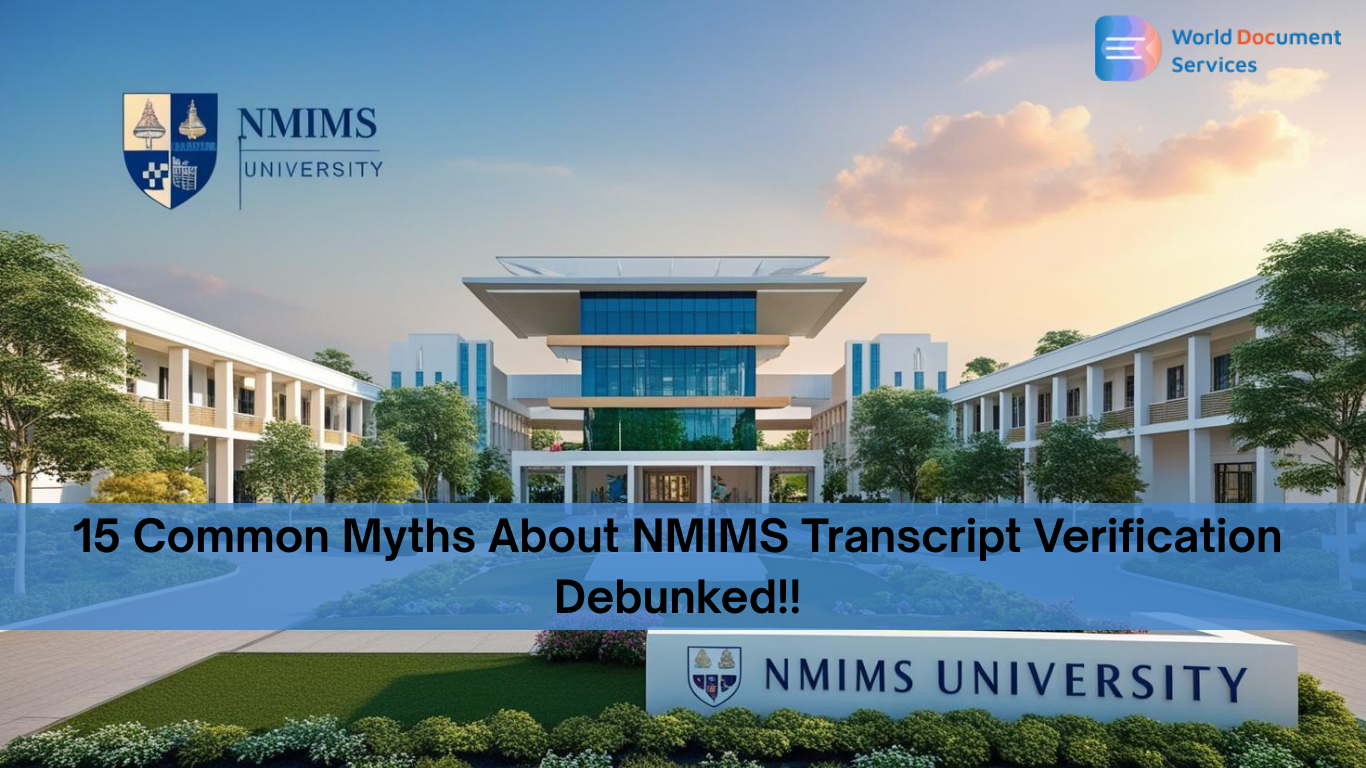
Higher education, and particularly global applications, requires transcript verification. This can be a part of the process that students and alumni of NMIMS (Narsee Monjee Institute of Management Studies) are often misinformed about. Whether you’re applying for higher studies, immigration status, or WES evaluation, there are often misconceptions about the process.
In this blog, we will set aside the noise and debunk the 15 most common myths surrounding NMIMS transcript verification, clarify the real NMIMS transcript process and timelines, eligibility, etc.
Need help with your NMIMS transcript process? Contact Us Now!
✅ Myth 1: You Must Physically Visit the Campus for NMIMS Transcript Verification
Reality: Untrue. The NMIMS transcript process is now digital and frictionless. You can instigate and receive your NMIMS transcript request online through the official portal or from an authorized online transcript service provider.
✅ Myth 2: NMIMS Doesn’t Send Transcripts Directly to WES
Reality: NMIMS does send official transcripts directly to WES or any other evaluating body. You must only specify that WES is the transitioning destination and must include the WES reference number when applying for the NMIMS transcript for WES.
✅ Myth 3: Only Recent Graduates Can Request Transcripts
Reality: Alumni from any batch can request their NMIMS transcript. It does not matter if you graduated 2 years ago or 20 years ago; the NMIMS transcript online system is enabled for any verified alumni.
✅ Myth 4: NMIMS transcripts are automatically issued with your Degree
Reality: Transcripts are not automatically issued with degrees. Ideally, you have to request NMIMS transcripts formally through a transcript request form or through an authorized transcript service provider in India.
✅ Myth 5: Getting NMIMS Official Transcript Takes Months
Reality: If done through the proper channel (NMIMS portal or qualifying transcript service provider in India), it can take only 2 to 3 weeks to get the transcripts based on processing time and accuracy of documents.
✅ Myth 6: NMIMS Does Not Provide Online Services for Transcripts
Reality: NMIMS is embracing digitization. You can apply for a transcript online without the need to visit the university in person.
✅ Myth 7: Only WES Requires NMIMS Transcript Verification
Reality: While WES (World Education Services) is one of the most common recipients, NMIMS degree verification and transcripts are required for many other international universities, immigration authorities, and credential evaluators.
✅ Myth 8: You Need to Submit Original Documents for Transcript Processing
Reality: You do not need to submit original documents. Clear, scanned copies of your degree certificate, mark sheets, and ID proof are sufficient unless specifically asked otherwise.
✅ Myth 9: You Can’t Track Your Transcript Status Online
Reality: Whether you go through NMIMS directly or use a third-party online transcript service, tracking your application status is completely feasible through email updates or tracking links.
✅ Myth 10: NMIMS Doesn’t Support International Shipping
Reality: NMIMS transcripts can be shipped globally to institutions like WES, ECE, IQAS, and more. They use reputable courier services for secure and traceable delivery.
✅ Myth 11: All Courses From NMIMS Are Eligible for Transcripts
Reality: While most programs are eligible, certain short-term or non-degree certifications may not qualify for a full transcript. Always confirm eligibility before initiating your NMIMS transcript request.
✅ Myth 12: NMIMS Transcripts Cannot Be Sent Electronically
Reality: NMIMS can send digital transcripts, especially to evaluation agencies like WES, via secure digital transfer. However, always verify with your evaluator whether they accept electronic transcripts.
✅ Myth 13: The University Doesn’t Entertain Third-Party Transcript Requests
Reality: NMIMS works with authorized transcript service providers in India who can apply on your behalf, saving you time and effort. Just ensure proper authorization and documentation.
✅ Myth 14: Transcript Processing Is Prone to Errors and Delays
Reality: Delays typically happen due to incomplete or inaccurate documents submitted. If all paperwork is in order and payment is made correctly, the process is quite efficient.
✅ Myth 15: You Can’t Request Both Transcript and Degree Verification Together
Reality: You can request both your NMIMS document verification and transcript in one go. Most service providers offer bundled packages to streamline this.
Key Takeaways
The NMIMS transcript verification process has evolved with time. From being a tedious paper-based model to a now digitized and streamlined process, it’s easier than ever for alumni and students to apply for transcripts online, get their NMIMS official transcripts verified, and send them to institutions worldwide.
Whether you’re applying to WES, immigrating, or simply organizing your academic records, partnering with the best transcript services in India can make a significant difference in time and efficiency.
Frequently Asked Questions (FAQs)
Q: How can I apply for my NMIMS transcripts online?
A: You can apply via the official NMIMS portal or through an authorized online transcript service that handles the process end-to-end, including document pickup, notarization, university liaison, and delivery.
Q: Can I send my NMIMS transcript directly to WES?
A: Yes, NMIMS facilitates direct dispatch to WES. Just provide your WES Reference Number during the application.
Q: How long does the NMIMS transcript process take?
A: Generally, it takes 10-21 working days, depending on documentation accuracy and processing speed.
Q: Are digital transcripts from NMIMS acceptable to international agencies?
A: Yes, many agencies, including WES, accept digitally issued transcripts from NMIMS. However, confirm with the specific institution or authority.
Q: Can I apply for a transcript and degree verification at once?
A: Absolutely. Most service providers offer bundled services for NMIMS document verification, degree attestation, and transcript handling.
Conclusion
NMIMS alumni and students often encounter confusion around transcript processes, especially when dealing with international evaluations or immigration procedures. Don’t let these common myths derail your progress. By understanding the real NMIMS transcript process and working with a trusted transcript service provider in India, you can ensure smooth, compliant, and timely delivery of your academic documents.
If you’re looking for hassle-free support, explore verified online transcript services that can help you apply for transcripts online without delays or errors. Stay informed, act early, and keep your academic journey global-ready.
Download the World Document Services App
You may enjoy a hassle-free experience by downloading our mobile app from either the App Store or the Play Store. It works with both iOS and Android devices.

by Aayushi Thadwani | May 27, 2025 | Credential Evaluations

In today’s growing worldwide academic and work environment, credential recognition is becoming vital. There are so many possibilities, also, for studying, working, or immigrating abroad. Academic documents must conform to international standards. WES evaluators will often make that process easier in some cases. It’s fair to say that World Education Services (WES) is one of the world’s most credible credential evaluators and has been a trusted organization for credential evaluations for foreign degrees.
In this article, we will describe the importance of WES credential evaluation, the importance of using the correct transcript service provider in India to assist you, and the potential impact it can have on your moving abroad journey.
Need help with your WES Evaluation Matters for Your Educational Documents? Contact Us Now!
Understanding WES Evaluation
WES evaluation is a formal process that assesses the educational credentials you obtained outside of the United States or Canada. It converts your academic qualifications into their North American equivalents, allowing institutions, employers, and immigration authorities to understand and trust your qualifications.
There are two primary types of WES credential evaluations:
- Document-by-Document Evaluation: Provides a basic description of each credential.
- Course-by-Course Evaluation: Offers a detailed analysis, including course names, credits, and grades in the U.S./Canadian format.
Importance of WES Credential Evaluation:
1. Essential for Higher Education
WES educational document evaluations are required by most North American universities and colleges as part of the admission formalities for international students. This ensures that the degree you obtained in your home country is legitimate and equivalent to the standards of local education.
2. Required for Immigration
The requirement for WES document assessment is mandatory for fully competent skilled immigration to Canada Under programs like Express Entry. If WES has not evaluated your education levels, then you cannot recognize any education points toward it.
3. Acceptable by Employers
International employers use these evaluation services to help determine the qualifications of their foreign candidates. If you include an approved WES evaluation on your resume, this acts as a seal of credibility.
4. Reduces Misinterpretation
Education systems differ across countries. A WES transcript evaluation ensures your academic achievements are not undervalued due to a lack of understanding or clarity.
5. Speeds Up Processes
Most institutions trust WES, which reduces turnaround times for admissions, hiring, or immigration processing.
WES Evaluation for Foreign Degrees: Step-by-Step Guide
- Create a WES Account Online.
- Choose the purpose of evaluation (e.g., education, employment, immigration).
- Select Evaluation Type.
- Depending on your requirement, choose Document-by-Document or Course-by-Course.
- Gather Required Academic Documents.
- This includes degree certificates, transcripts, and, in some cases, mark sheets.
- Get Documents Verified by the University.
- Universities must seal and stamp your transcripts before sending them directly to WES or via a verified transcript service provider in India like World Document Services.
- Track Your Evaluation Status (Use your WES dashboard to monitor updates in real time).
Common Challenges in WES Educational Document Evaluation:
- University Delays: Many Indian universities take weeks or months to process transcripts.
- Document Rejection: Improper sealing or formatting can lead to rejection.
- Manual Errors: Misspellings or incorrect grades can delay your WES evaluation service.
- Communication Gaps: Some universities lack the infrastructure for international communication or online tracking.
To bypass these challenges, applicants now turn to online transcript services.
Why Choose Online Transcript Services?
Leveraging a reliable online transcript service saves time, ensures accuracy, and provides transparency. With digitalization and the demand for global mobility, many students and professionals prefer to apply for transcripts online rather than stand in university queues.
Look for services that offer:
- Direct university coordination
- Quality checks for WES compliance
- End-to-end tracking
- Fast delivery
- Data Confidentiality
If you’re seeking reliability, opt for the best transcript services in India, like World Document Services, which are experienced, WES-compliant, and provide pan-India coverage.
Choosing the Right Transcript Service Provider in India:
An experienced transcript service provider in India can efficiently bridge the gap between your university and WES.
Ensure they:
- Understand WES documentation requirements.
- Have strong university networks.
- Provide digitized tracking and updates.
- Offer secure packaging and dispatch.
- Provide customer support for queries.
Conclusion
The importance of WES evaluation in today’s interconnected world cannot be overstated. Whether you’re chasing academic goals, immigration dreams, or global career aspirations, WES provides the foundation for your credentials to be recognized and respected.
Using online transcript services from the best transcript services in India can significantly simplify the process, reduce stress, and ensure your documents meet WES standards. Don’t let paperwork become a roadblock in your journey. Opt for trusted WES transcript evaluation support today and set the course for international success.
Download the World Document Services App
You may enjoy a hassle-free experience by downloading our mobile app from either the App Store or the Play Store. It works with both iOS and Android devices.
FAQs
Q: What is a WES evaluation, and why do I need it?
A: A WES evaluation assesses and verifies your academic documents from outside North America. It’s essential for studying, working, or immigrating to the U.S. or Canada to ensure your foreign degrees are recognized.
Q: How long does a WES credential evaluation take?
A: Typically, WES takes about seven business days after receiving all required documents. Delays often occur due to transcript issues, so using an experienced transcript service provider in India is advisable.
Q: Can I apply for a WES evaluation directly?
A: Yes, you can create a WES account and apply directly. However, sending verified transcripts through your university or a professional online transcript service is mandatory for evaluation to proceed.
Q: What documents are required for WES evaluation for Indian students?
A: You’ll need your degree certificate, consolidated mark sheet (transcript), and, in some cases, individual semester mark sheets. All must be attested and sealed by your university registrar or controller of examinations.
Q: How can I choose the best transcript service provider in India?
A: Look for verified experience, WES familiarity, transparent processes, end-to-end handling, and strong university ties. The best transcript services in India are prompt, responsive, and WES-compliant.
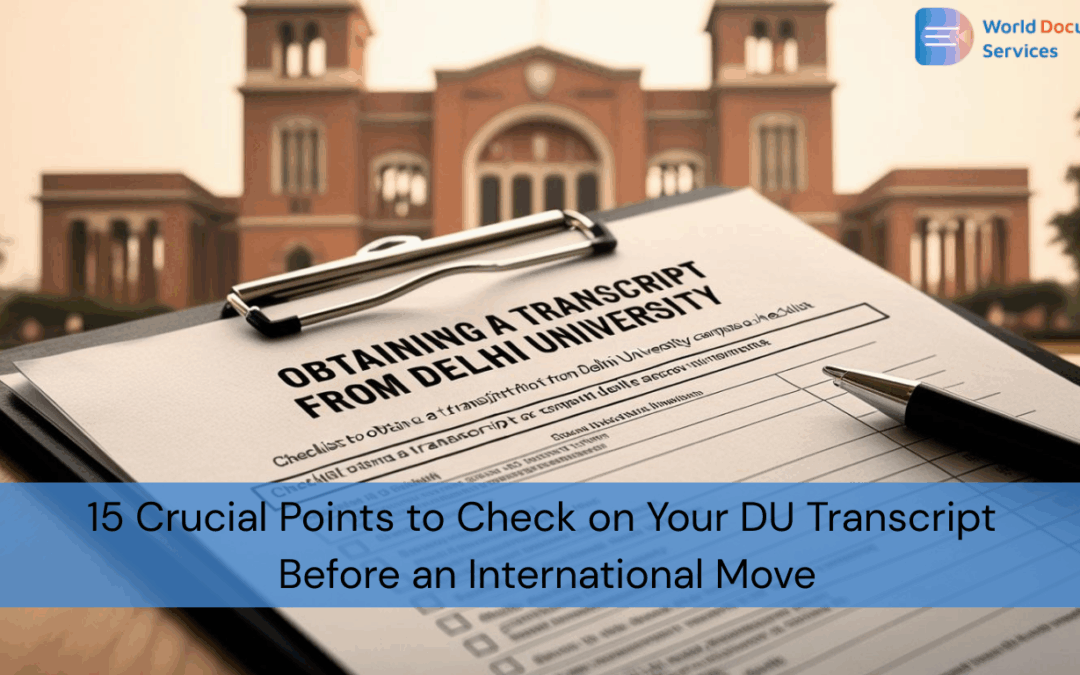
by Aayushi Thadwani | May 17, 2025 | Transcripts from University
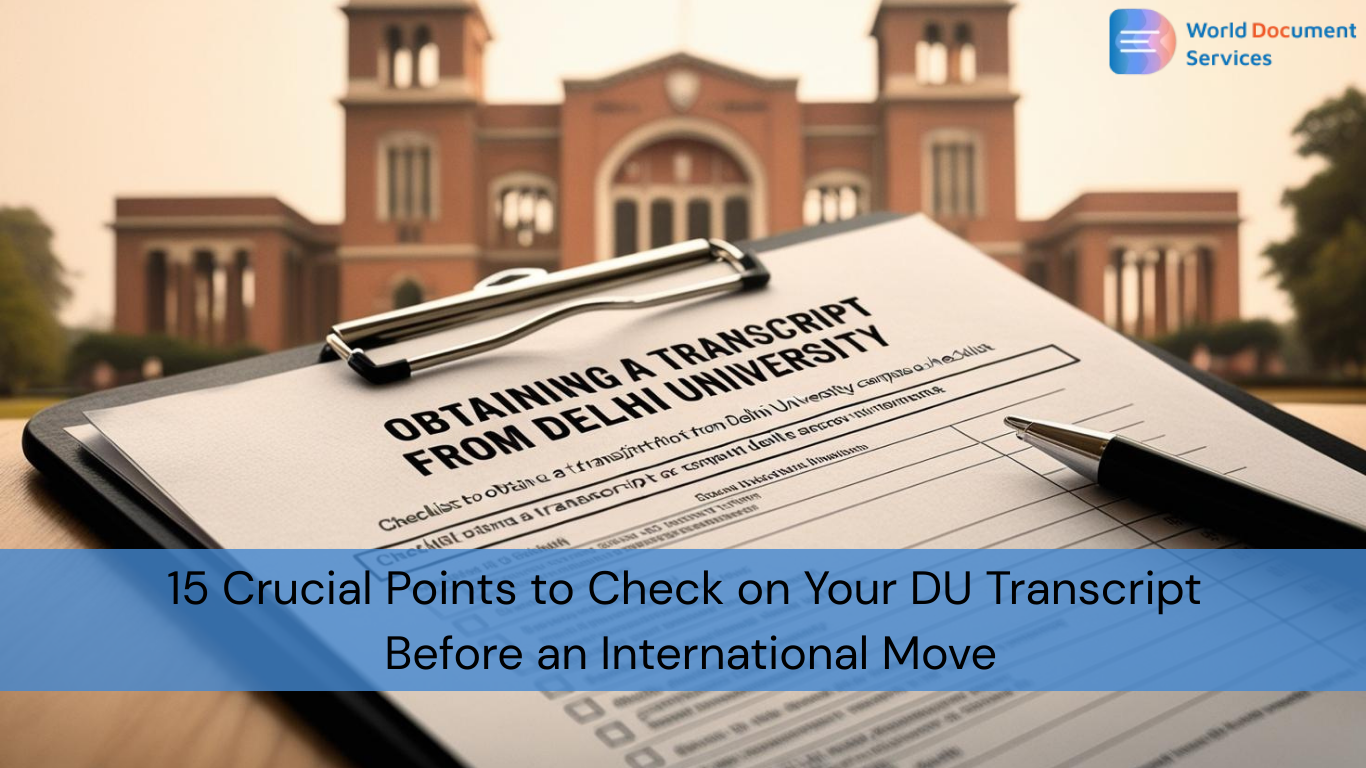
When preparing to move abroad for education or employment, your academic documents can either smoothen or stall your plans. If you have graduated from Delhi University, your DU transcript is a vital component of your application file. Whether you’re applying for higher education, immigration, or job opportunities overseas, your transcript must be accurate, verified, and complete.
This article outlines 15 important items to check on your Delhi University transcript before you send it to foreign universities. We will also examine Delhi University document checks, online transcript services, and the best way to apply for transcripts online with reliable transcript service providers in India.
Need help with your Delhi University transcript? Contact Us Now!
Why is a DU Transcript Important for International Aspirants?
Your DU transcript for international studies is more than just a collection of marksheets. It is an official summary of your academic record that has been combined, verified, and sealed by the university. Universities, credential evaluators, and immigration institutions abroad view transcripts as an important indicator of academic eligibility.
Getting your Delhi University transcript evaluation right the first time can save you weeks (if not months) of delays, especially with deadlines and the WES or ECE documents required.
15 Important Items to Verify on your DU Transcript prior to Sending it Overseas
1. Correct Student Name
The name on the transcript must match your passport exactly; this means no extra initials, no misspellings, and no middle names left off.
2. Correct Course Title
Make sure your course name (e.g., B.A. (Hons) in Political Science) is included in full and not just some sort of abbreviation or incorrectly listed.
3. College Name Must be Present
The Delhi university transcripts must have your college (e.g., Miranda House, Hindu College.) It is important that it is present, as you do not want any confusion when the foreign university is screening your application.
4. University Seal & Registrar Signature
Check that the official DU seal and Registrar’s signature are present. These validate the authenticity of the transcript.
5. Consistent Marks Format
Verify that all marks are listed clearly, preferably in percentage format. If not, get a grading scale or conversion sheet to accompany the transcript for foreign institutions.
6. Semester-Wise Breakup
Ensure your transcript includes a semester-wise breakup of subjects and marks. Some foreign universities reject cumulative-only transcripts.
7. Subject Codes and Titles
Check for correct subject names and codes. This is essential during Delhi University transcript evaluation by credential agencies like WES or IQAS.
8. Date of Issue of Transcript
The issue date should be recent, preferably within 3–6 months of your application submission. Outdated transcripts can lead to rejections.
9. Language of Transcript
The transcript should be in English. If any part is in Hindi or another language, request an official English version from DU.
10. Transcript Request Number
DU usually assigns a tracking number when you apply for a transcript online. Keep a screenshot or receipt to follow up.
11. Proper Sealing and Envelope
For WES or other foreign bodies, DU transcripts for foreign universities must be in a sealed envelope, signed and stamped on the flap. Never open this seal yourself.
12. Transcript vs. Degree Certificate
Don’t confuse your degree certificate with your transcript. You need both; one shows you completed the degree, and the other shows how you performed.
13. Backlog or Re-evaluation Entries
If you have backlogs or revaluation cases, ensure they are accurately reflected or clarified. Some transcripts show “Improvement” or “Re-eval” next to the score—these should not alarm foreign institutions if documented well.
14. Correct Contact Details
Ensure your name, email, and contact number (as listed with DU) are correct. Errors can hinder correspondence or document dispatches.
15. Transcript Format Compatibility
Different countries require different formats. Your DU transcript for international studies should comply with the destination country’s standard—Canada and the US often require semester-wise, sealed transcripts, Germany requires subject credit information.
Delhi University Document Verification and Online Access
With digitization on the rise, Delhi University document verification has become more accessible. You can now apply for a transcript online via DU’s official portal or through third-party online transcript services. While DU’s internal process is dependable, it is notoriously slow. Many students prefer outsourcing to trusted transcript service providers in India for faster turnaround and courier tracking.
Recommended steps:
- Scan all mark sheets and degree certificates.
- Apply via DU’s web portal or through a verified vendor.
- Pay the prescribed fee online.
- Choose a dispatch method- direct to your address or to a foreign agency/university.
Pro Tip: Some of the best transcript services in India also offer WES verification support, courier tracking, and document escalation if DU delays the process.
Mistakes That Could Jeopardize Your Abroad Plan:
- Misspelling your name or course.
- Sending unsealed transcripts to WES or a university.
- Not requesting semester-wise transcripts.
- Ignoring backlog mention or clarification.
- Applying through non-verified agents.
Each of these can either delay or reject your application, potentially costing you an admission cycle or immigration quota.
Conclusion
The importance of a flawless Delhi University transcript cannot be overstated. It’s your academic identity, and any errors in it can cost you both time and opportunity. Carefully auditing all 15 points listed above will ensure your transcript is ready for international scrutiny, whether by a university, employer, or immigration officer.
Make smart use of online transcript services and partner with the best transcript service provider in India for seamless execution. From tracking your application to securely dispatching your documents abroad, these service providers can make the process smoother, faster, and mistake-free.
Download the World Document Services App
You may enjoy a hassle-free experience by downloading our mobile app from either the App Store or the Play Store. It works with both iOS and Android devices.
FAQs
Q: How long does it take to get a DU transcript?
A: If applied directly via DU, it may take 20–40 working days. Using a transcript service provider in India can sometimes reduce this to 10–15 working days.
Q: Can I apply for a DU transcript online?
A: Yes, Delhi University offers an online application process. However, delays are common, which is why many opt for online transcript services.
Q: Is it mandatory to send sealed transcripts to WES or foreign universities?
A: Yes, for DU transcripts for foreign universities, the envelope must be sealed and stamped by DU and sent directly or handed unopened to the institution.
Q: What documents are needed for Delhi University document verification?
A: You’ll need scanned copies of all marksheets, your degree certificate, your ID proof, and a passport-size photo. Some cases may require a notarized affidavit for backlog clarifications.
Q: Which are the best transcript service providers in India for DU students?
A: Trusted names include World Document Services. Always verify their official partnerships with Delhi University before proceeding.

by Aayushi Thadwani | May 6, 2025 | Transcripts Services
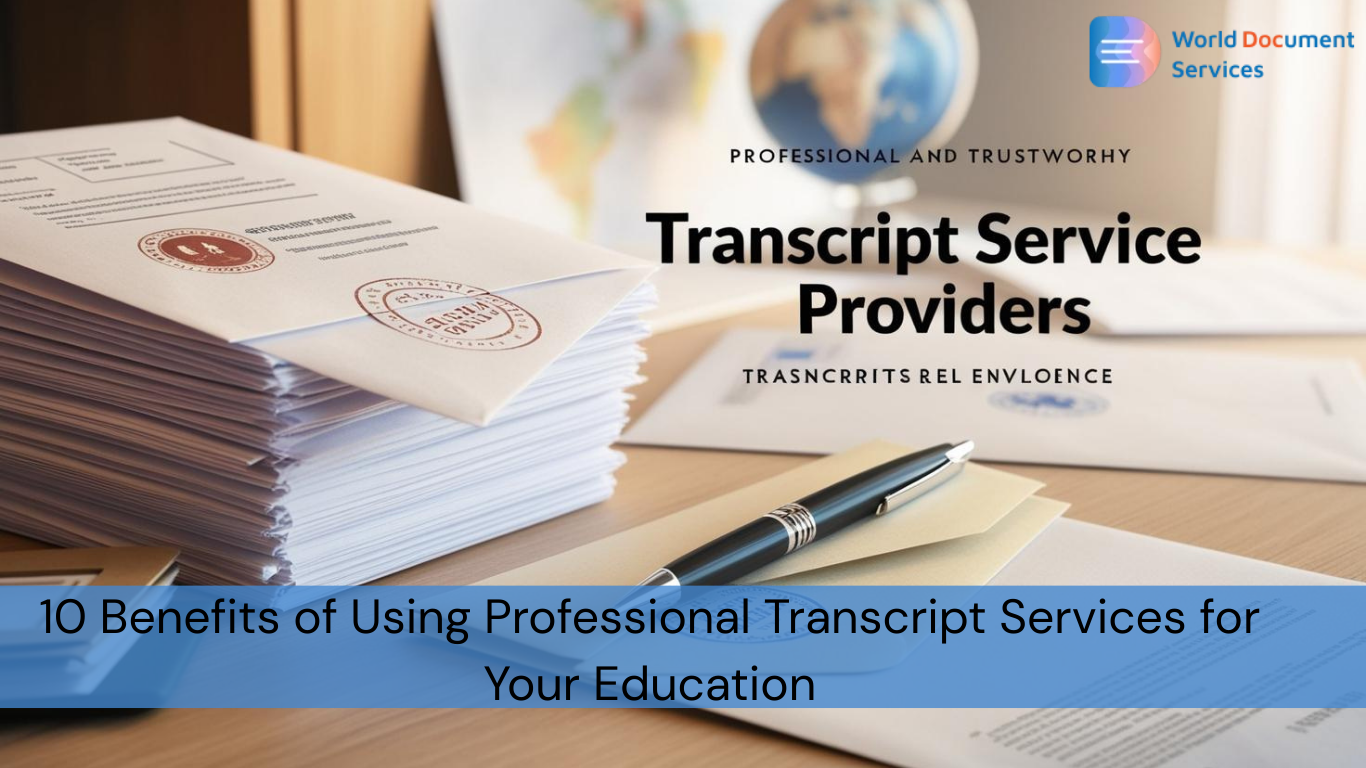
In an ever-globalizing and digitized academic landscape, having fast, accurate, and reliable documentation is more important than it has ever been. Whether you are applying for a place at an overseas university, applying to immigrate, or transferring from one educational institution to another, academic transcripts are the most valuable record of your academic achievements. And it is at this stage where professional transcript services become valuable. Professional transcript services securely and accurately present academic records in a timely manner that meets institutional and country guidelines.
Need help with your Professional Transcript Services for Your Education? Contact Us Now!
Top 10 Advantages of Using a Professional Transcript Service
Here are the top 10 advantages of using a professional transcript service related to your education:
1. Accuracy and Authenticity:
One of the most important reasons to opt for a good transcript service is the assurance of accuracy and genuineness. These professional services collaborate directly with educational institutions to ensure that all grades, courses, and achievements are documented without errors. This reduces the chances of rejection or delays due to discrepancies.
2. Saves Time and Energy:
Transcripts requested on your behalf, especially when performed internationally, can be a very time-consuming and hassling process. Online transcript services are designed to make the whole process easy. They take care of documentation, coordinate your university, and arrange for delivery. This allows students to focus on a class or the application process without administrative headaches.
3. Compliance with International Standards:
Different universities and countries have different requirements for how your transcript should be formatted, translated, and notarized. Experienced transcript services have had experience with these variations and make sure your documents conform to necessary global standards and are legitimate and accepted anywhere in the world.
4. Safe and Secure Service:
Educational records can be confidential and personal. Trustworthy educational document services follow established policies and procedures to ensure the privacy and confidentiality of your transcripts. With secure portals, encrypted communications, and verified delivery, these services provide a safe pathway for your academic documents.
5. End-to-End Process Management:
Whether it’s retrieving the documents from your university or sending them to the university or authority of your choice, university transcript services provide you with end-to-end process management. No more travelling between departments, facilitating contact between offices, or dealing with courier companies – everything will be fitted for you efficiently and professionally!
6. Translation and Notarization Services:
Many international academic or immigration organizations require documentation in specific languages or require a notarized version. Most transcript services for students will provide certified translations and notarization at the earliest possible at the same place, making the whole experience hassle-free and integrated.
7. Tracking and Status Updates:
One of the standout advantages of online transcript solutions is transparency. You receive timely updates on your transcript’s progress right from initiation to delivery. This reduces anxiety and allows you to plan your applications with confidence.
8. Cost-Effective in the Long Run:
Although there is a cost associated with professional transcript services, it is often worthwhile. Even a small mistake in a self-handled process could result in rejection, missing deadlines, and reapplying for the same service at a cost. An expert-handled process reduces your risk.
9. Customized Solutions for Diverse Needs:
Transcript services for students can accommodate and individually cater to students, who may be new grads, working professionals, or convenient students returning to school after a long absence from academia with backlogs, dated formats, or institutions that changed rules.
10. Stress-Free Documentation Support:
Navigating with formalistic processes in unknown countries or areas can be difficult. Educational document services can help you with peace of mind by taking responsibility for each phase of your fulfilled requirement, right from documentation to dispatch, and therefore relieving you of the stress and administrative burden.
Frequently Asked Questions
Q: What are professional transcript services?
A: Professional transcript services assist students and professionals in obtaining, verifying, formatting, translating, and dispatching academic transcripts according to national and international requirements.
Q: Why should I use academic transcript services instead of doing it myself?
A: Professional services offer accuracy, save time, ensure compliance, and provide additional services like notarization, translation, and secure dispatch, all of which can be complex and time-consuming when handled individually.
Also, most of the professionals are already working somewhere, so for them to visit their country or city to get those documents from the university is too bothersome, and genuine service providers take care of the entire thing on their behalf.
Q: Can I get transcripts from any university through these services?
A: Most transcript services have connections to many universities. However, you should verify the service provider’s affiliation or experience with the institution before beginning the process.
Q: Are online transcript solutions secure and reliable?
A: Yes, reputable providers use encrypted platforms and verified communication methods and provide tracking facilities to ensure your data is handled safely.
Q: How long does it take to get my transcripts through these services?
A: Timelines vary depending on the university and destination, but most professional transcript services expedite the process, often completing it within a few weeks if documents are in order.
Conclusion
In the competitive and often convoluted world of global education, there is simply no substitute for trustworthy academic documentation. When you choose to use professional transcript services, you are assured of accurate and legitimate transcripts, and you will save precious time and worries. Whether you are applying to a university overseas, applying for a professional license, or completing a foreign immigration procedure, trusted student transcript services are essential to a streamlined, safe, and successful application experience. Invest in the best support possible; your academic work deserves quality and professionalism.
Download the World Document Services App
You may enjoy a hassle-free experience by downloading our mobile app from either the App Store or the Play Store. It works with both iOS and Android devices.

by Aayushi Thadwani | May 2, 2025 | Most Viewed
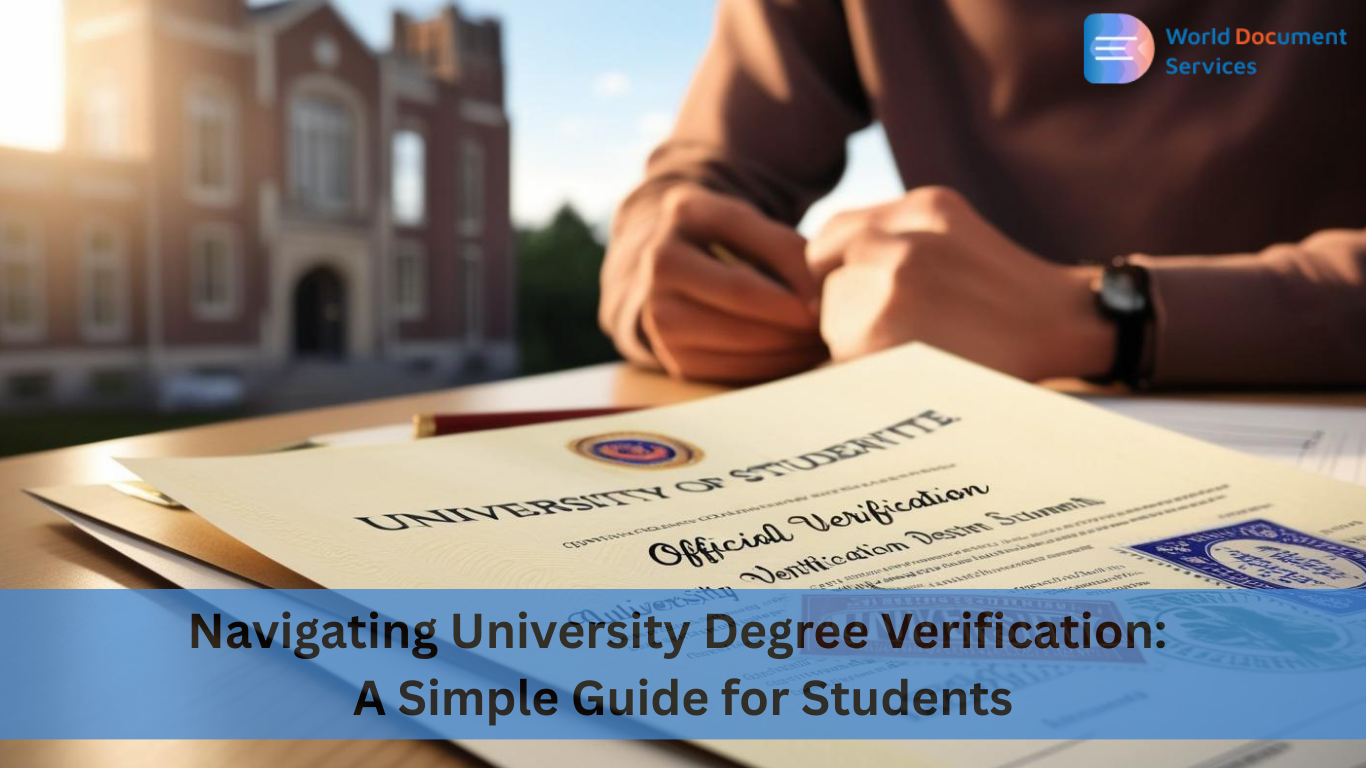
In the global academic and professional spheres today, credential verification is more than just a formality; it’s a necessity. It doesn’t matter whether you’re applying for postgraduate studies overseas, applying for a government job, or moving to another country to accept a job offer; university degree verification is a fundamental way of demonstrating your academic legitimacy.
This guide is meant to support you in understanding the degree verification process, explain the criticality of verification of academic credentials, and demonstrate ways to expedite the verification process using online degree verification solutions. When you finish reading this, you’ll know what you are looking for, how to complete it quickly and efficiently, and how to avoid many of the common mistakes that delay or stagnate thousands of students from degrees each year.
Need help with your University Degree Verification? Contact Us Now!
What is university degree verification?
University degree verification is a formal process in which the educational institution authenticates a student’s degree or academic record; the rate at which verification occurs can vary. Verification can include authentication of a degree certificate, mark sheets, and all supporting documents issued by a university. Most verification comes from employers, embassies, verification agencies, or other educational institutions.
Why is it important?
In the digital age and competitive market, there are many fake degrees and fake educational records. Institutions and employers want to ensure that the documents you present are legitimate and issued by a certified entity.
Understanding the Degree Verification Process
The degree verification process generally follows these core steps:
- Submission of Application: Students or third parties (like verification agencies) must submit a formal request to the university along with the necessary documents.
- Document Review: The university examines the submitted credentials to ensure they match their official records.
- Authentication and Endorsement: If verified, the university stamps or seals the document as “Verified” or provides a formal verification letter.
- Dispatch or Upload: In some cases, these documents are physically couriered to the requesting authority. Increasingly, however, this is done through degree certificate verification online portals.
This process can vary depending on the country, university, and the nature of the document.
Shift Towards Online Degree Verification
Many institutions and countries have shifted to online degree verification systems. These platforms allow students, alumni, and verification agencies to access secure databases that confirm educational records in real-time.
Some prominent platforms include
- National Academic Depository (NAD) in India
- DigiLocker Integration for University Certificates
- Student Clearinghouse in the United States
- WES (World Education Services) for international credential evaluation
- In-house university document verification portals are managed directly by institutions.
Benefits of degree certificate verification online include
- Faster turnaround time
- Digital and paperless transactions
- Reduced risk of lost or forged documents
- Secure access control
- Compliance with global verification standards
If your university is not yet online, you’ll need to rely on traditional manual processes.
What is Academic Credential Verification?
Academic credential verification is a broader term that includes verifying not just your degree certificate but also the following:
- Transcript/Marksheet Verification
- Course completion certificates
- Medium of Instruction (MOI) letters
- Provisional degrees
- Revaluation letters (if applicable)
- And any academic documentation tied to your credentials
This step is vital when you’re planning to study or work abroad, especially in countries like Canada, the U.S., Australia, and Germany, which require credential equivalency evaluations.
How to Initiate University Document Verification
Follow these best practices to ensure smooth university document verification:
- Know the Requirement: Understand whether the end institution requires original verified documents, soft copies, or attested versions.
- Prepare Your Documents: Keep your degree, marksheets, ID proofs, passport copies, and application forms handy.
- Use Official Channels: Always request verification through your university’s registrar’s office or official website. Avoid third-party agents unless they are officially authorized.
- Track Your Application: If online portals are available, use tracking features. If not, maintain communication via email or phone with university personnel.
- Pay the Fees Promptly: Some universities charge a nominal fee for processing verifications or couriering documents abroad. Ensure you make timely payments to avoid delays.
Common Pitfalls to Avoid
- Incomplete Applications: Even a single missing document can delay the process.
- Wrong Authority Contacted: Always verify the designated contact point at your university.
- Procrastination: Initiate the verification process at least 1-2 months before your deadline.
- Not Cross-Checking the Format Required by the End-User: Some embassies or companies require sealed envelopes; others demand digital signatures.
Conclusion:
In the digital age, university degree verification is more accessible yet more critical than ever. Whether you’re dealing with academic credential verification for international study or online degree verification for employment purposes, a well-prepared and strategic approach can save you time, money, and unnecessary stress.
Always stay informed about your university’s verification mechanisms. And most importantly, treat your academic documents with the same level of seriousness as your passport or visa. They are your educational identity in the global marketplace.
Download the World Document Services App
You may enjoy a hassle-free experience by downloading our mobile app from either the App Store or the Play Store. It works with both iOS and Android devices.
Frequently Asked Questions (FAQs)
Q: How long does the university degree verification process take?
A: Typically, 10 to 30 working days, depending on the university and mode (manual or online). Delays are common during peak academic seasons.
Q: Can I verify my degree online if I graduated several years ago?
A: Yes, many universities offer online degree verification, even for alumni. However, you may need to update your student profile or contact the registrar.
Q: Is notarization the same as academic credential verification?
A: No. Notarization only confirms your identity and the authenticity of the document copy, not the academic content or issuance by the university.
Q: Can I send verified documents directly to a third-party institution, or does the university need to send them?
A: It depends. For most embassy or credential evaluation agencies, the documents must be sent directly by the university in a sealed envelope or secure digital channel.
Q: What if my university doesn’t offer online verification?
A: In such cases, you’ll need to go through manual routes—submitting physical copies and using postal services or authorized agents recognized by the university.











 Call Us
Call Us Mail Us
Mail Us WhatsApp
WhatsApp
